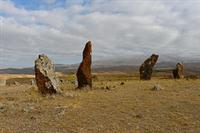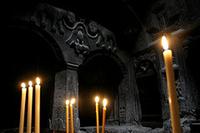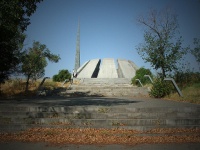Despite some truly heavy-hitting historical and cultural attractions, Armenia remains an underappreciated tourist destination. As the first country in the world to adopt Christianity it is no surprise that Armenia is dotted with ancient churches and monasteries, making the country primarily a religious tourist destination. Being off the radar of package tours and a little hard to get to only adds to the mysterious biblical allure of the region.The biggest tourist attractions include the 17th-century Khor Virap Monastery, an important pilgrimage site loomed over by the iconic Mount Ararat, where Noah is said to have landed the Ark; the Etchmiadzin Cathedral, reputed to be the oldest state-built church in the world; the 2,000-year-old Garni Temple, a gloriously well-preserved Pagan temple; the archaeological site of Carahunge, called the 'Stonehenge of Armenia'; and the UNESCO-listed Monastery of Geghard, built in 1215.Visitors will also enjoy making their way along the scenic Debed Canyon, past old villages and monasteries such as Haghpat and Sanahin. The Erebuni Archaeological Museum dates back to before the establishment of Rome, giving insight into the lives of the great kings of Urartu. Sunset over Norovank ('New Monastery') is said to be one of the most spectacular sights in the country.In the global imagination Armenia is also strongly associated with the horrific Armenian Genocide of 1915, during which Turkish troops killed about 1.5 million Armenians. This tragic history is memorialised at Tsitsernakaberd, part museum and part memorial, where travellers can learn about the Armenian holocaust and pay their respects.

Yerevan's Cascade Complex - an enormous white stairwell built into the hillside, replete with flowing water fountains to mimic a natural cascade - links Yerevan's CBD with the Monument Neighbourhood at the top of the hill, and is an important cultural hub in Armenia's capital city. The awe-inspiring structure plays host to a variety of free cultural events that operate year-round, from music concerts, to art exhibitions, and more. The Cascade Complex is a wonderful place to walk, jog or bike around, while soaking up magnificent views of Mount Ararat and Yerevan's city centre.
Address : Tamanyan Street, Yerevan
Website : www.cmf.am

Carahunge is an ancient astronomical observatory complex consisting of over 200 stones huddled on a hilltop. Often referred to as 'Armenia's Stonehenge', this description may be unjust: Armenia's stone circle complex was established long before Stonehenge, making it one of the oldest megalithic sites in the world outside of Turkey. The stones still display the angled holes that were carved into them by Armenian priests for the purpose of tracking celestial bodies. Also referred to as Zorats Karer, Carahunge is perhaps one of the last places in the world you can visit and literally be surrounded by 7,500 years of human history.
Address : Near Goris, Syunik Province
Website : www.carahunge.com

The Greco-Roman Garni Temple is a popular tourist attraction, putting the small, rural village of Garni on the map. This 2,000-year-old building was constructed out of basalt on the banks of the Azat River and was the summer residence of the Armenian Kings, featuring constructions like a two-storey royal summer palace, a bath complex, a church, a cemetery and a Greco-Roman temple built in the Ionic style. While much of the temple was destroyed in the ensuing millennia, it was restored to its former glory in the 1960s. Archaeologists are still working at the site, and many artefacts have been uncovered.
Address : Garni

The Monastery of Geghard, or 'Monastery of the Spear', is perhaps Armenia's most memorable attraction. Partially carved out of an adjacent mountain, and surrounded by the spectacular cliffs of the Azat River gorge, the monastery was founded in the 4th Century at the site of a sacred spring deep inside the cave. The impressive main chapel was built in 1215 and is a lasting testament to the devotion and architectural skill of the Armenian people. The monastery complex takes its name from the weapon which wounded Jesus Christ, and was supposedly brought to Armenia by Jude the Apostle.
Address : Near Goght, Kotayk Province

Tsitsernakaberd is a memorial honouring the memory of the victims of the 1915 Armenian Genocide that took place in the Ottoman Empire. It is estimated that over one million Armenians were killed in the genocide. The monument is made up of two sections: the 140-foot (44m) stele symbolizes the national rebirth of Armenians, while the circular construction of 12 slabs represents the 12 lost provinces in present day Turkey. Every year on 24 April, Genocide Remembrance Day, hundreds of thousands of people gather at the monument and lay flowers. The attached museum tells the story of the genocide through photographs, films and newspaper clippings.
Address : Memorial Complex of Tsitsernakaberd, Yerevan
Website : www.genocide-museum.am

Travel Guide powered by Word Travels, copyright © 2023 Globe Media Ltd. By its very nature information in this travel guide is subject to change at short notice and travellers are urged to verify information on which they're relying with the relevant authorities. Neither Globe Media Ltd nor Travel Vogue can accept any responsibility for any loss or inconvenience to any person as a result of information contained above.